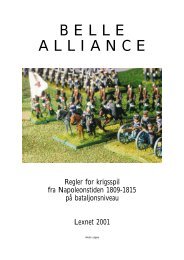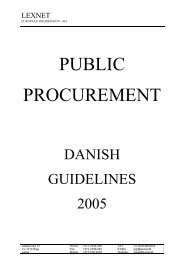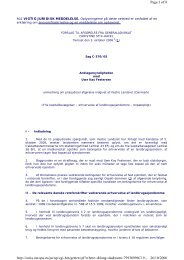Master's Program 2004/2005 Technical and Fiscal Barriers ... - Lexnet
Master's Program 2004/2005 Technical and Fiscal Barriers ... - Lexnet
Master's Program 2004/2005 Technical and Fiscal Barriers ... - Lexnet
You also want an ePaper? Increase the reach of your titles
YUMPU automatically turns print PDFs into web optimized ePapers that Google loves.
61997J0067 European Court reports 1998 Page I-08033 7<br />
aim of protecting biological diversity, such aim being recognised, inter alia, by Council Directive<br />
92/43/EEC of 21 May 1992 on the conservation of natural habitats <strong>and</strong> of wild fauna <strong>and</strong> flora (OJ 1992<br />
L 206, p. 7) <strong>and</strong> by the Convention on Biological Diversity signed at Rio de Janeiro on 5 June 1992,<br />
approved on behalf of the European Community by Council Decision 93/626/EEC of 25 October 1993 (OJ<br />
1993 L 309, p. 1; hereinafter `the Rio Convention'). The Danish Government goes on to explain that the<br />
subspecies Apis mellifera mellifera (Læsø brown bee) is disappearing <strong>and</strong> can be preserved only on the<br />
isl<strong>and</strong> of Læsø, so that the measure adopted is necessary to prevent the disappearance of the species <strong>and</strong> is<br />
proportionate to the aim pursued. Moreover, the Decision does not affect the possibility of carrying on<br />
bee-keeping on the isl<strong>and</strong> but merely regulates the species of bee which may be used.<br />
26 The Danish Government concludes by referring to numerous scientific studies establishing the particular<br />
nature of that subspecies of bee in relation to others.<br />
27 As its main argument, the Norwegian Government submits that the Danish legislation is justified on<br />
environmental protection grounds in accordance with Article 30 of the Treaty <strong>and</strong> the judgment in Case<br />
120/78 REWE-Zentral v Bundesmonopolverwaltung für Branntwein [1979] ECR 649 (`Cassis de Dijon'),<br />
paragraph 8.<br />
28 In the alternative, like the Italian Government <strong>and</strong> the Commission, it considers that the preservation of<br />
a rare <strong>and</strong> threatened species falls within the protection of the health <strong>and</strong> life of animals referred to in<br />
Article 36 of the Treaty.<br />
29 In the Norwegian Government's submission, the establishment of pure breeding areas is the only means<br />
of preserving the Læsø brown bee.<br />
30 The Commission maintains that the same ground of justification should be upheld if the species were<br />
not rare <strong>and</strong> threatened, but it was desirable on scientific grounds to breed a pure strain.<br />
31 On the question of the existence of a disappearing subspecies Apis mellifera mellifera (Læsø brown<br />
bee), the Commission considers that this is an evidential matter which is therefore one for the national<br />
court to determine. It maintains that the prohibition should not extend to the keeping of brown bees of the<br />
species Apis mellifera mellifera from other Member States or from non-member countries in the absence<br />
of a valid reason to justify such a restriction, <strong>and</strong> points out that such a prohibition must not constitute a<br />
means of arbitrary discrimination or be aimed at protecting certain occupational interests.<br />
32 The Italian Government states that there are several subspecies of Apis mellifera mellifera, identifiable<br />
as strains <strong>and</strong> within the latter as ecotypes, representing the result of a natural process of adaptation to<br />
environmental conditions <strong>and</strong> various territories.<br />
33 On this question, the Court considers that measures to preserve an indigenous animal population with<br />
distinct characteristics contribute to the maintenance of biodiversity by ensuring the survival of the<br />
population concerned. By so doing, they are aimed at protecting the life of those animals <strong>and</strong> are capable<br />
of being justified under Article 36 of the Treaty.<br />
34 From the point of view of such conservation of biodiversity, it is immaterial whether the object of<br />
protection is a separate subspecies, a distinct strain within any given species or merely a local colony, so<br />
long as the populations in question have characteristics distinguishing them from others <strong>and</strong> are therefore<br />
judged worthy of protection either to shelter them from a risk of extinction that is more or less imminent,<br />
or, even in the absence of such risk, on account of a scientific or other interest in preserving the pure<br />
population at the location concerned.<br />
35 It does, however, have to be determined whether the national legislation was necessary <strong>and</strong><br />
proportionate in relation to its aim of protection, or whether it would have been possible to achieve the<br />
same<br />
© An extract from a JUSTIS database<br />
60







